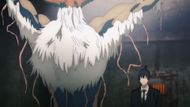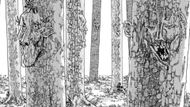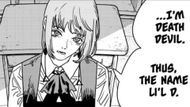Chainsaw Man part 2 reveals Fujimoto's most calculated design decision: the Future Devil's tree form. While Aki exchanged half his lifespan for precognition, the devil's wooden anatomy wasn't arbitrary symbolism. The gnarled branch and hollow eye socket served as blueprints for humanity's ultimate fate within the Aging Devil's twisted reality.
Fujimoto embedded breadcrumbs throughout the Future Devil's skeletal tree structure that would bloom into horrifying relevance during Chainsaw Man part 2. The devil's organic design directly mirrors the tree transformation that awaits humans who push their minds beyond breaking points. Aki unknowingly contracted with a preview of mankind's inevitable conclusion when Death Devil's influence wanes

The Future Devil’s lower body looks like a tree sprouting from the ground, its trunk and branches rising into a humanoid form with spread arms and a horned head. This tree-like form wasn't merely an aesthetic decision by Fujimoto.
The branching structure symbolizes the multiple pathways and possibilities that define future scenarios. This visual metaphor becomes particularly poignant when considering Aki's tragic fate despite his ability to glimpse what lies ahead.
The connection becomes crystal clear through the Aging Devil arc in Chainsaw Man part 2. The trees in the Aging's world were once trapped humans who sought to escape their world, with countless failed attempts leading to them turning into trees upon reaching the culmination of thought. This revelation entirely reshapes the interpretation of the Future Devil’s design.
Inside the Aging Devil’s domain, humans slowly lose their reason and ultimately become trees. The transformation occurs naturally after approximately two thousand years of mental exhaustion. This process reveals a fundamental aspect of human nature within Chainsaw Man's universe.
The Death Devil Connection in Chainsaw Man Part 2

The tree transformation connects directly to themes surrounding the Death Devil, another primordial fear that shapes Chainsaw Man part 2's narrative. The relationship between aging, death, and the tree-like state suggests a cyclical nature of existence within Fujimoto's world-building.
When humans reach their mental limits through endless rumination and fear of what's to come, they naturally transform into trees. This biological inevitability makes the Future Devil's tree form an excellent representation of humanity's ultimate destiny when confronted with infinite possibilities.
The tree symbolism established through the Future Devil's design continues influencing Chainsaw Man part 2's direction. Understanding that humans naturally transform into trees after mental exhaustion provides context for various character arcs and potential plot developments.

The Death Devil's role as a primordial fear becomes more influential when considering that death might be the only escape from the tree transformation fate. This produces a compelling dichotomy between assuming mortality and succumbing to endless contemplation.
Fujimoto's strategic design preferences ascertain that seemingly simple aesthetic decisions can carry deep narrative importance. The Future Devil's tree-like appearance helps as a visual anchor linking past events to current developments in Chainsaw Man part 2.
The complex associations between the Future Devil, Aging Devil, and Death Devil show Fujimoto's ability to layer meaning within his creations. It forms a tapestry of symbolism that rewards careful readers with a deeper knowledge of his complex narrative format.
